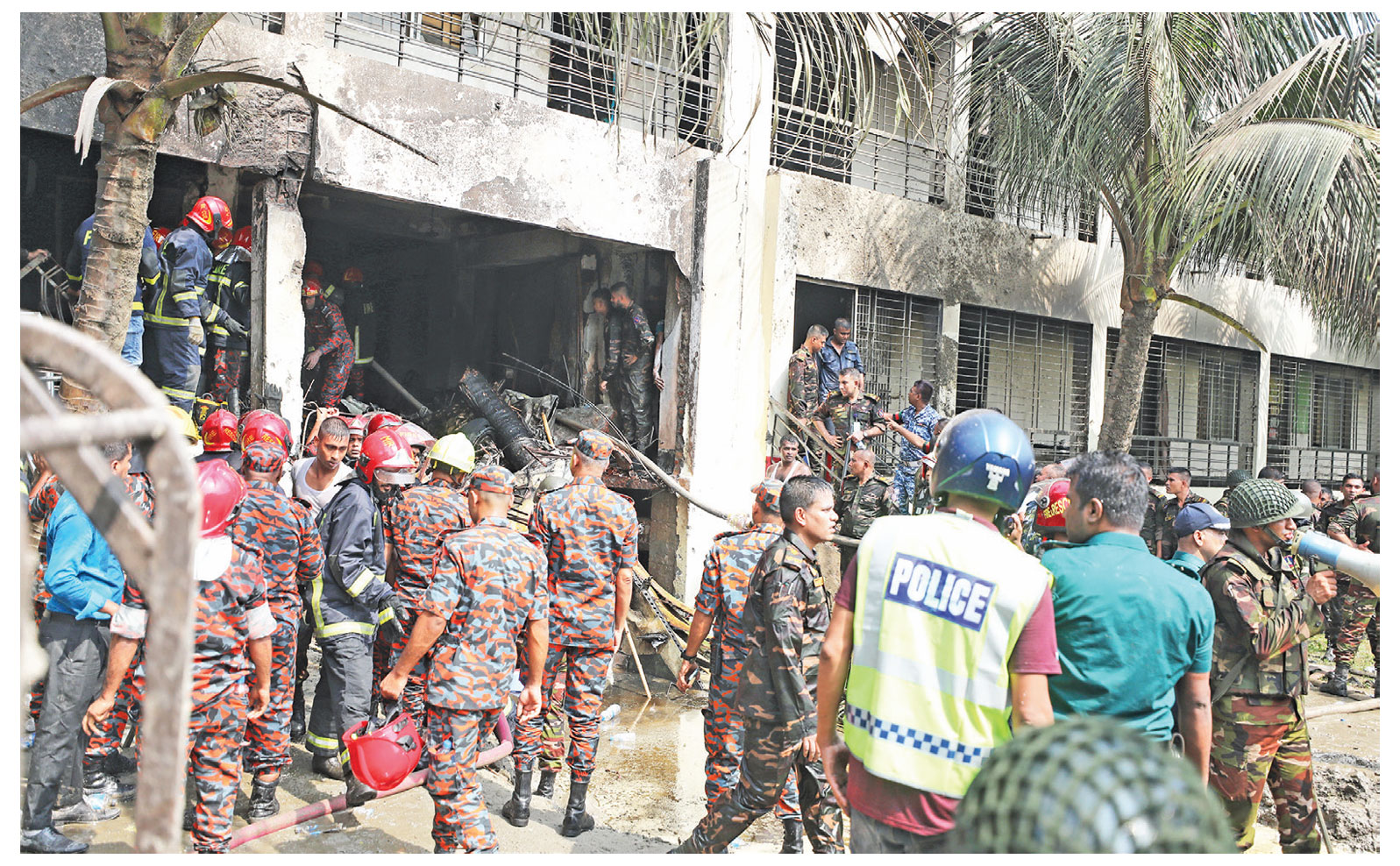
Wares Ali Khan
The clear blue sky of Uttara turned into a canvas of horror on 21 July this year. Shortly after midday, nearly at 1:20 PM, a training aircraft tragically crashed into a building of the Uttara Milestone School and College, shattering lives of many students. The devastating accident has so far claimed the lives of at least 32 individuals and left some 165 injured, a majority of whom are children and adolescents. On the other hand, the painful sight of fellow classmates’ burning in fire and their desperate cries have certainly inflicted a deep, invisible wound in the minds of students who survived. The empty seats in their classrooms will only remind them of those friends they will never see again.
Even those who were not physically present there on that fretful Monday are shrouded in a heavy cloak of grief. This tragedy has cast a long shadow, not just over the students of Milestone School, but over the entire nation. Kids and school-goers have seen the heart-wrenching images and stories on TV channels, news outlets and social media. The collective shock has given way to a profound mental health crisis, a trauma that demands immediate attention.
Major traumatic events leave an indelible mark on the psyche of all who witness them, but for children, tender-hearted adolescent kids, the impact can be particularly devastating and long-lasting. The developing minds of children and adolescents are more vulnerable to severe stresses caused by such horrific experiences. This can lead to a heightened risk of developing mental health disorders. In the immediate aftermath of the disaster, children may experience acute stress, frequent disorder, brief psychosis, panic attacks, anxiety, and an abnormal sense of grief. The memories of such a traumatic event can remain with a child for a long time, potentially leading to personality problems in the future.

So, it is necessary to provide the surviving students with immediate psychological support in the wake of such a catastrophe. This initial intervention, often referred to as Psychological First Aid (PFA), aims to reduce immediate distress and foster coping mechanisms. The first and foremost step is to ensure that the children feel safe. This involves removing them from the scene of the trauma and providing a secure and comforting environment. Simple acts of comfort, such as a warm blanket, a calm voice, and the presence of a trusted adult, can have a profound impact on a distressed child in this mentally rugged situation.
In this situation, the children may exhibit signs of intense emotions. It is vital to help them calm down and orient themselves. Facilitating contact with family members and friends provides a crucial sense of connection and support. Honesty is important, but information should be delivered in a way that a child can comprehend without being re-traumatised. Allowing children to make small decisions, like what to eat or what game to play, can help restore a sense of control that was lost during the traumatic event.
The healing of such a profound trauma requires a long time. It requires a concerted and sustained effort from parents, teachers and community. Parents are the primary source of comfort and security for a child. It is essential for them to spend quality time with children, listen to their fears and concerns without judgment, and be patient with their recovery process.
Parents should create a safe space for children where they can express their feelings. Children should be shielded from watching repetitive and graphic news coverage of the tragedy to prevent re-traumatisation. And re-establishing daily routines can provide a sense of stability and normalcy in a world that feels chaotic. Children learn by observing adults. Therefore, it is imperative for parents and guardians to manage their children’s stress and grief in a healthy way.
Learning seats can be a vital sanctuary for healing and recovery. Schools should foster a climate of empathy and understanding, where students feel safe to share their feelings. Integrating mental health professionals into the school system is crucial to identify and support students who are struggling. This can include individual and group counselling sessions. Training educators to recognise the signs of trauma and respond appropriately is essential. Academic pressure and accomplishing lessons should be eased for learners who are grieving and traumatised. Encouraging students to support one another can create a strong sense of community and shared healing.
The response to this tragedy must extend beyond individual families and schools. Community members, leaders, social workers and community organisations all have a role to play. Making mental health resources accessible to all affected families is paramount. While acknowledging the immense pain, it is also important to focus on the holistic strength and resilience of the community
The path to healing for the children of the Uttara tragedy may be really long and arduous. The emotional wounds will require time, patience and compassionate support to heal. By working together, we can help these young minds overcome their trauma and emerge into a future where the sky is once again a symbol of aspiration, not that of horror.
__________________________________________________
The writer is an educator and social worker

